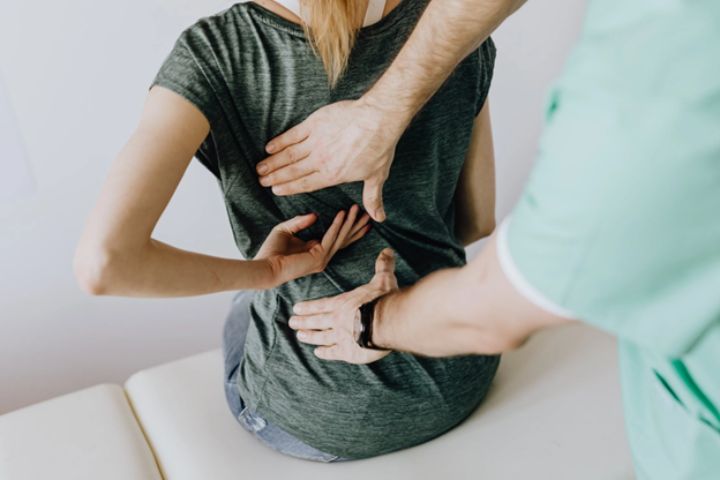As we age, one of the smartest things we can do for our mobility and independence is learn how to protect our hip joints and the structures around them.
To protect your hip joint, focus on building strong glute and core muscles, keeping your hamstrings and hip flexors flexible, and avoiding habits that place stress on the joint. Stay mindful of your walking and sitting posture, and avoid crossing your legs or overstriding.
These simple habits can help you avoid pain and keep your hips healthy over time. If you would prefer to watch our guide on this topic, rather than read, here is our full video on how to protect the hip and low back:
In this article, we’ll break down the basics of lower quadrant joint protection—focusing on the low back, SI joint, and hips—so you can stay active and pain-free for years to come. We’ll also be referring back to some of the basic tips we provided in our guide to protecting our joints as we age.
What is the lower quadrant?
In physical therapy, we divide the body into four quadrants: upper left, upper right, lower left, and lower right. The lower quadrant includes the low back, sacroiliac (SI) joint, hips, knees, and ankles. For the purposes of this article, we’re zeroing in on the upper portion of that chain (the hips and low back), which plays a central role in nearly every movement you make—from walking and standing to lifting and squatting.
The foundation: low back support and core strength
The low back contains small joints on either side of each vertebral segment. These joints are constantly under compressive and shearing forces, especially during everyday movements like sitting, bending, or twisting. It’s no surprise that these forces are among the most common causes of low back pain.
So, what protects the hip joint and the rest of the lower quadrant? It starts with overall health: stay hydrated, eat well, and maintain both strength and range of motion in the muscles that support your spine and hips.
Your core muscles—including deep spinal stabilizers and the abdominal wall—form the base of support for everything above and below. A strong core combined with flexible hamstrings and hip flexors can help prevent imbalances that pull the spine into painful positions.

Posture and movement patterns matter
Modern life often leads to poor sitting posture. If you’re at a desk all day, you may slump forward, stretching joint capsules and inhibiting key muscles that are meant to stabilize your spine. Many people compensate by arching their backs too much—creating instability and discomfort.
To support the hip joint and low back, aim for:
- Strong glutes
- Flexible hamstrings
- Good sitting and standing posture
- Core strength, especially in the abdominals
We’ve covered sitting ergonomics and how to fix posture in some of our articles and videos in the past—if you’re struggling with low back or hip tension, those are worth reading and watching.
The SI joint: misunderstood but important
The sacroiliac (SI) joint doesn’t get much attention, but it plays a subtle, stabilizing role between your spine and hips. It’s a plane joint, which means it doesn’t move much. In many men, it fuses with age. In women—especially those who are hypermobile, have had children, or trained as dancers or gymnasts—it often remains mobile and can become irritated.
There are no muscles that move the SI joint directly, but habits like sitting with your legs crossed, taking long or exaggerated steps, or walking on a treadmill with too much hip motion can stress it.
To protect the SI joint:
- Avoid crossing your legs when sitting
- Pay attention to your stride length when walking or hiking
- Be cautious with deep hip flexion, especially during pregnancy

For more information on this topic, see our full article and video on at-home SI joint release exercises.
How to protect your hip joint
When people talk about hip pain, they often assume it’s the bones themselves. But unless you’re dealing with bone-on-bone arthritis, most hip joint pain comes from the soft tissues surrounding the joint. Articular cartilage doesn’t have nerves, so the pain is more likely coming from tight hip capsules, weak glutes, or altered gait mechanics.
The hip is a ball and socket joint and one of the primary weight bearing joints in the body. That makes it particularly vulnerable if alignment or muscle balance is off. Developing a balanced exercise routine that includes strength, mobility, and endurance can go a long way to prevent injury and protect the joint.
If you want to know how to protect the hip joint, here’s what we recommend:
- Avoid sitting with your legs crossed
- Improve hip flexor flexibility
- Maintain hamstring flexibility
- Strengthen your glutes and core
- Practice good walking mechanics—shortened steps, inward toeing, and forward trunk lean can all contribute to hip dysfunction
- Maintain a healthy weight to reduce load on your hips and knees
In hypermobile individuals—especially women—core and hip strength are your best tools for long-term joint protection and preventing early joint replacement.
A note about body weight and hip health
Excess body weight can significantly increase the strain placed on your hips, knees, and lower back. Because the hip joint is a major weight bearing joint, carrying extra weight increases the risk of joint pain, cartilage breakdown, and poor movement mechanics over time.
This tip is helpful enough for some patients that it becomes a central theme in their recovery—we even occasionally offer physical therapy with a weight loss focus for just this reason.
Maintaining a good, healthy weight through regular exercise and proper nutrition is one of the most effective ways to reduce unnecessary joint stress and preserve long-term hip health.
Final thoughts
If you’re wondering how to protect your hip joint, start with small, daily habits: sit well, move well, and strengthen the right muscles. The hips don’t exist in isolation—they’re part of a system. By taking care of the structures above and below the hip, you’re giving yourself the best chance at healthy movement and fewer injuries.
When your hips are healthy, your hip and knee mechanics work better together, improving your body’s ability to move with less pain and more efficiency. Don’t underestimate the impact of lifestyle choices either—smoking increases inflammation and degrades joint and bone health over time.
In the next posts, we’ll move further down the chain to explore the knees and ankles. Until then, stay strong, stay mobile, and listen to your body.

















